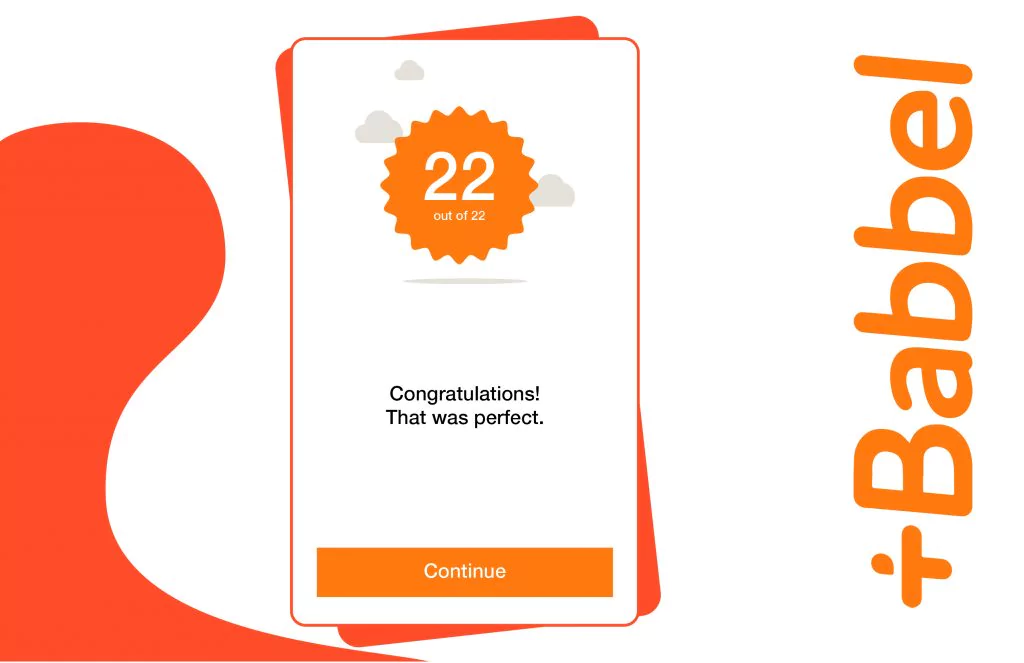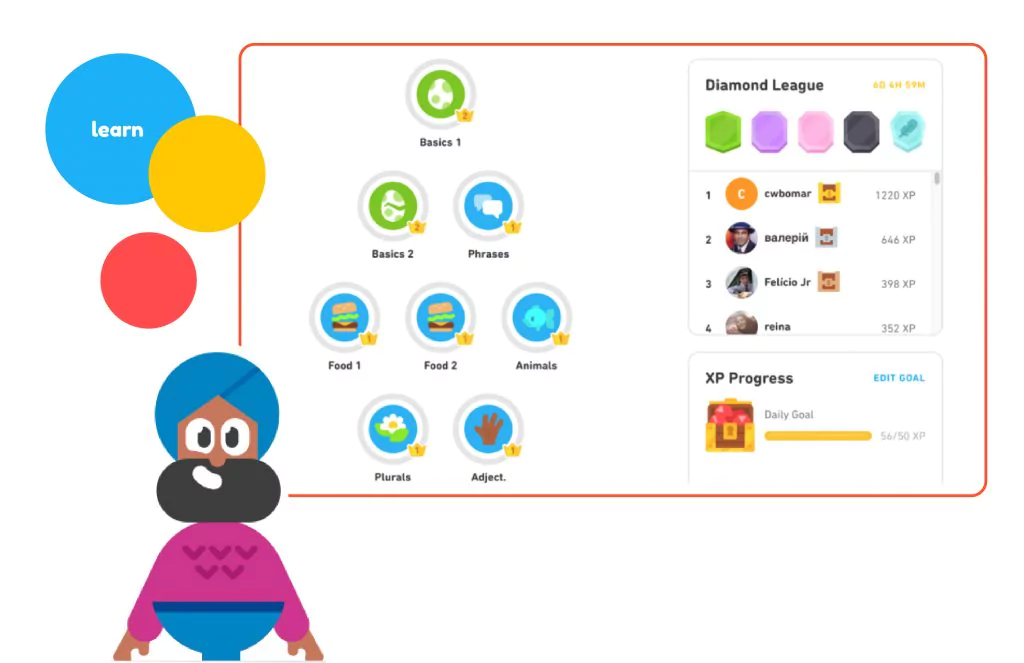Duolingo is one of the most popular free language-learning apps with over 500 million downloads and 40 million active users. It’s developed by Luis von Ahn, a computer science professor born in Guatemala, and Severin Hacker, his Ph.D. student from Switzerland.
How did two computer science engineers with no linguistic background manage to create a language learning application that conquered the world? Von Ahn grew up in Guatemala City where learning English was a costly privilege for many people. With a goal to expand and democratize access to education, von Ahn and Hacker decided to create a free and effective learning solution, which had no analogs at that time. And they perfectly coped with this task.
The startup founders understood that free access and efficacious educational content would not make their app the most downloaded one. Hacker and von Ahn needed something else. They decided to make a product truly appealing for users who, in turn, would popularize it with others. In other words, they came up with a product-led growth strategy, a strategy that lowers the cost of acquiring users while increasing engagement and retention.
Here are nine lessons from one of the most successful language-learning startups. We hope they’ll inspire you to develop your own app that will one day – who knows – grow into Duolingo’s main competitor.
And in case you need help, our team is here for you. JatApp has an extensive experience developing solutions for different niches, including education. One of our recent edtech projects includes PreQuest, a web platform for engaging online learning and training.
Lesson # 1. Identify user problem
When you want to create a language learning app (and any startup for that matter), you need to really understand user problems. When von Ahn decided to build his app, people who wanted to learn a foreign language needed to pay for lessons. Learning apps like Duolingo decided to change that by giving access to free education for everyone.
When we were developing PreQuest, we also had to overcome a specific challenge ‒ to create a solution that would encourage to study, and, at the same time, be captivating for students. And we successfully coped with the task by building an interactive platform that turns the learning process into a creative adventure.
What can we learn from this?
To build a successful educational app, you need to examine the market and identify underserved needs.
Lesson # 2. Provide a sleek mobile app in addition to your desktop application
Although von Ahn didn’t initially believe that Duolingo required a mobile app, he finally chose to follow the trends. He hired two interns to build a prototype for a mobile app. They created an application with a top-notch user experience.
A week after its release, the Duolingo iOS app became the most downloaded app in the education category. In 2013, it won “Apple’s iPhone App of the Year”, and a year after took the Crunchie award for “Best Education Startup”.
What can we learn from this?
To make your online language courses popular among users, you need to build a user-friendly mobile app in addition to your web or desktop version.
Lesson # 3. Add gamification to increase engagement and retention
Duolingo wanted to offer an unparalleled educational experience that would make users addicted to the app. A tried and true method for creating a sticky product is by turning a learning process into a game.
Duolingo consists of different language learning courses that include various learning stages (also called “skills”). Each skill has five lessons. Once completed, a user can move to the next skill, and then to the next one. It resembles the “leveling-up” model in games.
Leaderboards also encourage people to not give up on learning. Competition motivates learners and encourages them to do better. It also makes language learning more effective and enjoyable.
The Duolingo app has a feature called “streaks” which shows how many days in a row a user has completed at least one lesson. When you study one lesson a day, the streak automatically updates. Streaks work perfectly well because learners want to visualize their progress. Progress tracking contributes to the desire for non-stop learning.
When talking about gamification in other solutions, Babbel, for instance, gives you a score based on the number of correct answers. It’s like in a game ‒ you always want to beat your previous record.
Lingualia, a language platform for learning English and Spanish, also uses a “leveling up” model. Once you cope with one lesson, another one unlocks. Plus, there is a ranking table that evokes the competitive spirit.
PreQuest also proves that students rankings are effective within learning apps. Being a solution to help users prepare for the ISEB pre-tests, PreQuest provides a leaderboard for students to compare their results with others and try their best to get a higher score.
What can we learn from this?
Your language learning application should not look like a boring book with grammar and vocabulary exercises. It should be an interactive platform that turns a learning process into a fun and engaging experience.
Lesson # 4. Implement a rigorous A/B testing culture
Apart from making your app more engaging, during language learning app development you need to make sure all features are thoroughly tested.
Duolingo constantly runs A/B tests (when two versions of a feature are offered to different groups of users to understand which one works better) to see how students react to a new feature. For example, if you want to test push notifications, you can send two variants of the same notification and analyze how users react to them.
What can we learn from this?
When you want to deliver online language learning services and find how to make an app like Duolingo, you should meticulously test each function you plan to launch in order not to fly blind.
Lesson # 5. Focus on improving learning outcomes
When Luis von Ahn and Severin Hacker launched Duolingo, their goal was to deliver free learning content to students. But does free content ensure high learning efficiency? Not necessarily. That’s why, the Duolingo team turned the tedious (and, quite often, exhausting) process of studying into a competitive and dynamic game. And this approach proved to work: the number of Duolingo users is growing steadily year by year, and the company is now worth $6.5 billion.
Let’s look at another example, Babbel, a paid language learning application. The company provided free access to its language courses for three months to school and college students so they could continue studying at home during the COVID lockdown.
“We believe that language connects us all, and we are proud to share this philosophy…” – says Julie Hansen, CEO of Babbel.
What can we learn from this?
When you want to launch an app like Duolingo for learning a foreign language, your mission should be to educate the users. That might mean offering free access to educational content and supporting students at difficult times.
Lesson # 6. Prioritize the product
When a Duolingo mobile app was launched to the market, and 80% of traffic started coming from the mobile channel, the company decided to focus on improving their app’s functionality.
The Duolingo development team introduced various engagement hooks such as push notifications, game features like leaderboards, streaks, and more to create a viral product. By focusing on app development and not on monetization strategies, the app gained a devoted fan base who were willing to pay for additional benefits that were later offered in the form of a paid subscription.
Toucan, another great example, is a free Chrome language-learning extension that allows you to improve your vocabulary and see how certain words are used in context. The uniqueness of the extension is that you learn a foreign language while browsing the web. Once users see the benefits of this product, they can get a Toucan Premium subscription with extended functionality.
What can we learn from this?
Don’t start the language learning app development by creating paid features. First, build a product that people will fall in love with.
Lesson # 7. Experiment with monetization models
You can’t create an app and keep it free forever. One day you will have to monetize your platform to keep it running. Here are the two most popular monetization models for language learning startups:
-
Freemium
This model is currently used by Duolingo. Users can learn languages for free, and they can buy a premium subscription. The subscription delivers various benefits such as no ads, a mastery quiz, unlimited test outs, and the possibility to work on your mistakes. What’s more, Duolingo Plus enables offline language learning. Subscribers can download lessons to study even without an Internet connection.
A freemium model allows Duolingo to deliver free content for those who can’t afford to pay on a regular basis, and also to keep the app profitable.
-
Subscription-based
With this model, learners have to subscribe to get access to content. For example, Babbel is a subscription-based edtech startup. They offer paid plans only and already have 10 million active subscribers.
You can step back from traditional revenue models and come up with some specific ways to monetize your app. Duolingo introduced a Language Test (originally it was called a Test Center certification program) to verify the level of the foreign languages proficiency. It costs 49 dollars.
What can we learn from this?
You can choose between freemium and subscription-based models, and also experiment with other types of monetization options. To choose a winning pricing strategy, think of what your users will find most useful and will be ready to pay for.
Lesson # 8. Use personalized recommendation systems to provide appropriate content to users
Duolingo is an educational app ruled by artificial intelligence algorithms. Machine learning might indeed be a great solution to bring the online language learning experience closer to the offline teacher-student interaction.
Duolingo uses Birdbrain ‒ a personalized recommendation system. It constantly studies how much the learner knows and monitors the difficulty level of the materials that Duolingo provides. The system collects the data and makes an educated guess about whether the user will correctly comprehend this or that exercise. The more exercises Duolingo students complete, the more the app learns about how much they know. This way, beginner students are not scared by the advanced tasks, while more experienced learners don’t complain that the tasks are too easy for them.
What can we learn from this?
If you decide to make your own language app, don’t rely on random mechanisms to show tasks on the screen. Modern AI technologies enable the delivery of content that is definitely within the power of a specific user.
Lesson #9. Innovate
Watching Duolingo’s success, you might feel inspired to know how to create a language learning app just like Duolingo. But our advice is – think different.
One of the main reasons Duolingo became successful is that it offered something nobody did before: free access to educational content, game-based learning mechanics, a mobile app to study on the go. To build something as successful, you need to follow Duolingo’s footsteps and build an app that nobody has built before.
Be guided by unmet user needs and focus on learning outcomes. Design and technology are on us. Our team of professionals is empowered with the latest tools to build a powerful edtech solution for you. Contact us to learn more about the services we deliver and discuss your project details.

















